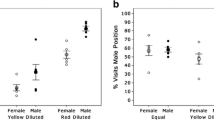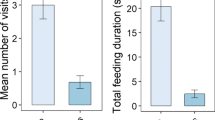Summary
Hummingbirds selected food in choice experiments based primarily on sugar concentration and secondarily on rate of intake and position. Sugar compositions had little effect on food choice, but the preferred sugar compositions appear to be the most common in nectars of plants visited by hummingbirds. Most amino acids in sugar water were not detected at concentrations found in nectars. Higher amino acid concentrations generally resulted in rejection. Hummingbirds did not necessarily select food in the laboratory to maximize feeding efficiency, but under natural circumstances similar choices could result in optimal feeding efficiencies. The determinants of food choice by hummingbirds provide a rationale for viewing factors important in plant competition for pollinator visits.
Similar content being viewed by others
References
Baker, H.G.: Sugar concentrations in nectars from hummingbird flowers. Biotropica 7, 137–141 (1975)
Baker, H.G., Baker, I.: Some anthecological aspects of the evolution of nectar producing flowers, particularly amino acid production in nectar, pp. 243–264. In: Taxonomy and ecology (N.H. Heywood, ed.), Syst. Assoc. Spec. Vol. 5 (1973)
Baker, H.G., Baker, I.: Studies of nectar-constitution and pollinator-plant coevolution. In: Coevolution of animals and plants (L.E. Gilbert, P.H. Raven, eds.). Austin: Univ. Texas Press 1975
De Benedictis, P., Gill, F.B., Hainsworth, F.R., Pyke, G.A., Wolf, L.L.: Optimal meal size in hummingbirds. Amer. Naturalist (in press)
Cody, M.L.: Optimization in ecology. Science 183, 1156–1164 (1974)
Covich, A.: Ecological economics of foraging among coevolving animals and plants. Ann. Missouri Bot. Garden 61, 794–805 (1974)
Dethier, V.G., Rhoades, M.V.: Sugar preference-aversion functions for the blowfly. J. exp. Zool. 126, 177–203 (1954)
Gill, F.B., Wolf, L.L.: Economics of feeding territoriality in the Golden-winged Sunbird. Ecology 56, 333–345 (1975a)
Gill, F.B., Wolf, L.L.: Foraging strategies and energetics of East African sunbirds at mistletoe flowers. Amer. Naturalist 109, 491–510 (1975b)
Hainsworth, F.R.: On the tongue of a hummingbird: Its role in the rate and energetics of feeding. Comp. Biochem. Physiol. 46, 65–78 (1973)
Hainsworth, F.R.: Food quality and foraging efficiency: The efficiency of sugar assimilation by hummingbirds. J. comp. Physiol. 88, 425–431 (1974)
Hainsworth, F.R., Wolf, L.L.: Energetics of nectar extraction in a small, high altitude, tropical hummingbird, Selasphorus flammula. J. comp. Physiol. 80, 377–387 (1972a)
Hainsworth, F.R., Wolf, L.L.: Power for hovering flight in relation to body size in hummingbirds. Amer. Naturalist 106, 589–596 (1972b)
Hainsworth, F.R., Wolf, L.L.: Crop volume, nectar concentration, and hummingbird energetics. Comp. Biochem. Physiol. 42, 359–366 (1972c)
Heinrich, B., Raven, P.: Energetics and pollination ecology. Science 176, 597–602 (1972)
Himmelman, T.H., Carefoot, T.H.: Seasonal changes in calorific value of three Pacific coast seaweeds, and their significance to some marine invertebrate herbivores. J. exp. mar. Biol. Ecol. 18, 139–151 (1975)
Hocking, B.: Insect-flower associations in the high Artic with special reference to nectar. Oikos 19, 359–388 (1968)
Kalat, J.W.: Taste salience depends on novelty, not concentration, in taste-aversion learning in the rat. J. comp. Physiol. Psychol. 86, 47–50 (1974)
Levin, D.A., Anderson, W.W.: Competition for pollinators between simultaneously flowering species. Amer. Naturalist 104, 455–467 (1970)
Percival, M.S.: Types of nectar in angiosperms. New Phytologist 60, 235–281 (1961)
Pulliam, H.R.: On the theory of optimal diets. Amer. Naturalist 108, 59–74 (1974)
Richter, C.P., Campbell, K.: Taste thresholds and taste preferences of rats for five common sugars. J. Nutr. 20, 37–46, (1940)
Rozenzweig, M.L., Sterner, P.W.: Population ecology of desert rodent communities: Body size and seed-husking as bases for heteromyid coexistence. Ecology 51, 217–224 (1970)
Royama, T.: Factors governing the hunting behavior and selection of food by the Great Tit (Parus major L.). J. Anim. Ecol. 39, 619–668 (1970)
Rozin, P.: Thiamine specific hunger, pp. 411–432. In: Alimentary canal (C.F. Code, ed.), Vol. 1, Handbook of physiol., Sect. 6 (1967)
Scheithauer, W.: Hummingbirds. New York: Crowell 1967
Schlamowitz, R., Hainsworth, F.R., Wolf, L.L.: On the tongues of sunbirds. Condor 78, 104–107 (1976)
Schoener, T.W.: Theory of feeding strategies. Ann. Rev. Ecol. Syst. 2, 369–404 (1971)
Smith, C.C., Follmer, D.: Food preferences of squirrels. Ecology 53, 82–91 (1972)
Snow, B.K., Snow, D.W.: Feeding niches of hummingbirds in a Trinidad valley. J. Anim. Ecol. 41, 471–485 (1972)
Stiles, F.G.: Ecology, flowering phenology, and hummingbird pollination of some Costa Rican Heliconia species. Ecology 56, 285–301 (1975)
Stiles, F.G.: Taste preferences, color preferences, and flower choice in hummingbirds. Condor 78, 10–26 (1976)
Tullock, G.: The coal tit as a careful shopper. Amer. Naturalist 105, 77–80 (1971)
Willson, M.F., Harmeson, J.C.: Seed preferences and digestive efficiency of cardinals and song sparrows. Condor 75, 225–234 (1973)
Wolf, L.L.: Energy intake and expenditures in a nectar feeding sunbird. Ecology 56, 102–104 (1975)
Wolf, L.L., Hainsworth, F.R.: Energetics: Expenditures and intakes. In: Chemical zoology (A. Brush, ed.), Vol. 10 (1977, in press)
Wolf, L.L., Hainsworth, F.R., Gill, F.B.: Foraging efficiences and time budgets in nectar-feeding birds. Ecology 56, 117–128 (1975)
Wolf, L.L., Hainsworth, F.R., Stiles, F.B.: Energetics of foraging: Rate and efficiency of nectar extraction by hummingbirds. Science 176, 1351–1352 (1972)
Wolf, L.L., Stiles, F.G., Hainsworth, F.R.: The ecological organization of a highland, tropical, hummingbird community. J. Anim. Ecol. 45, 349–380 (1976)
Wykes, G.R.: The preferences of honeybees for solutions of various sugars which occur in nectar. J. exp. Biol. 29, 511–518 (1952)
Zahler, L.R., Harper, A.E.: Effects of dietary amino acid pattern on food preference behavior of rats. J. comp. Physiol. Psychol. 81, 155–162 (1972)
Author information
Authors and Affiliations
Rights and permissions
About this article
Cite this article
Reed Haisworth, F., Wolf, L.L. Nectar Characteristics and food selection by hummingbirds. Oecologia 25, 101–113 (1976). https://doi.org/10.1007/BF00368847
Received:
Issue Date:
DOI: https://doi.org/10.1007/BF00368847




